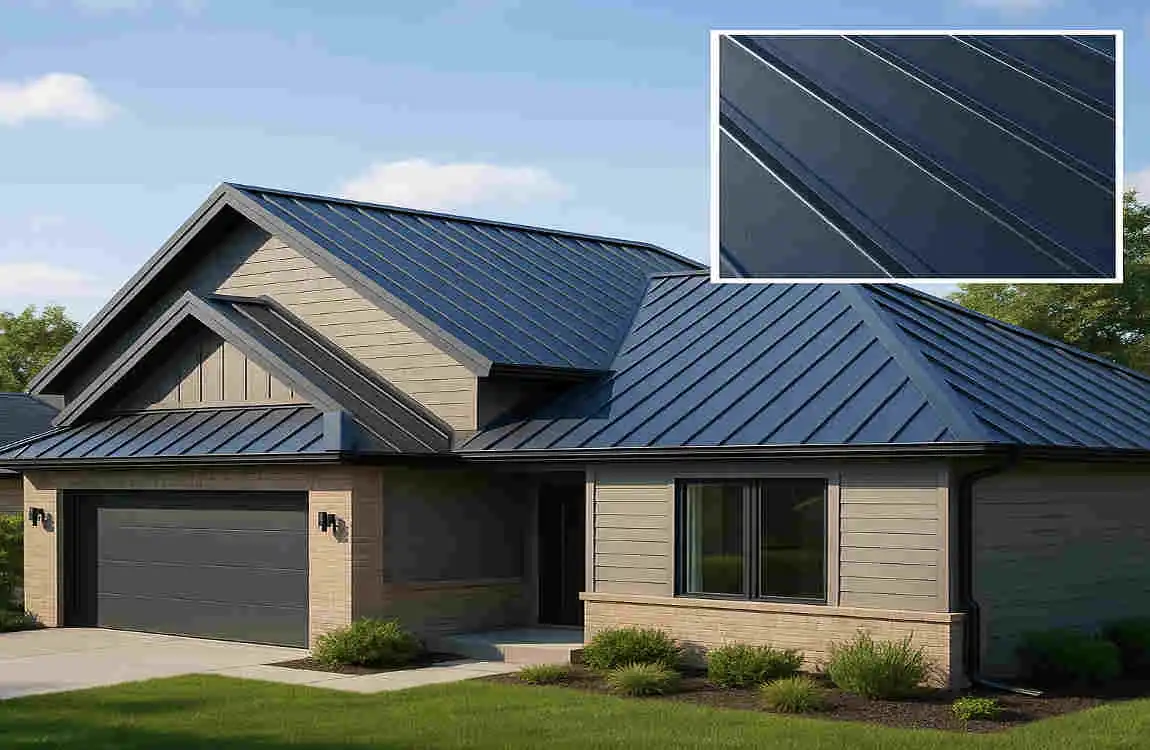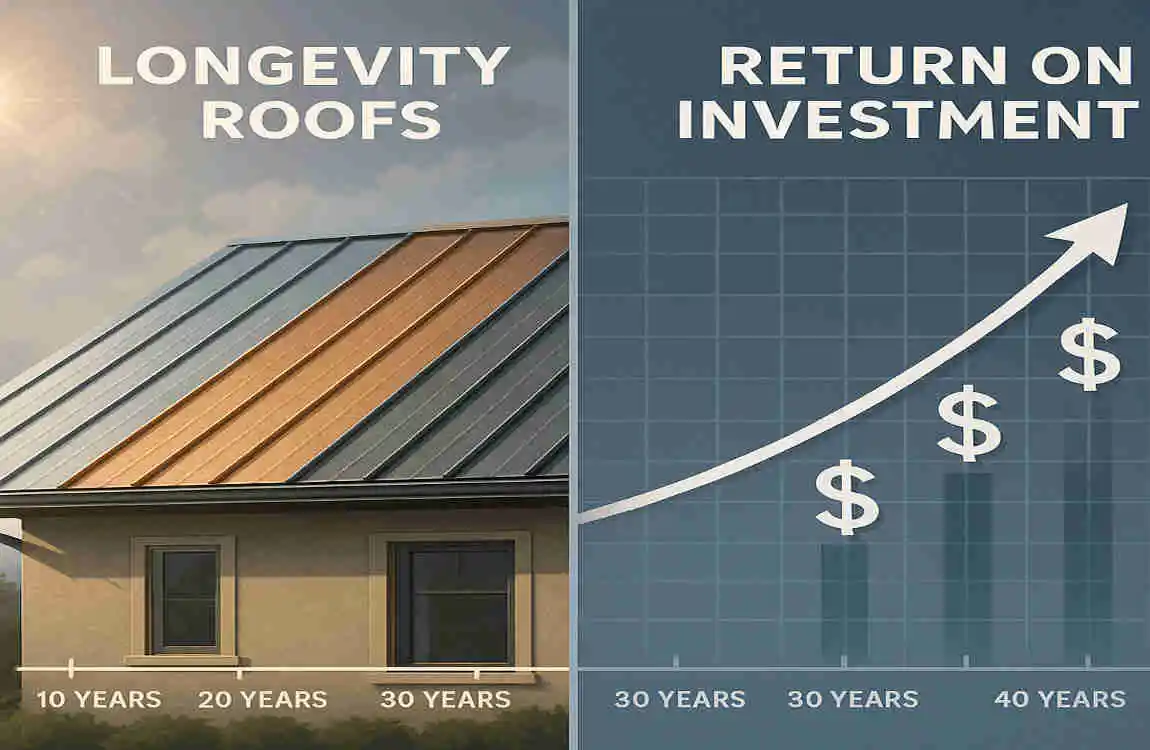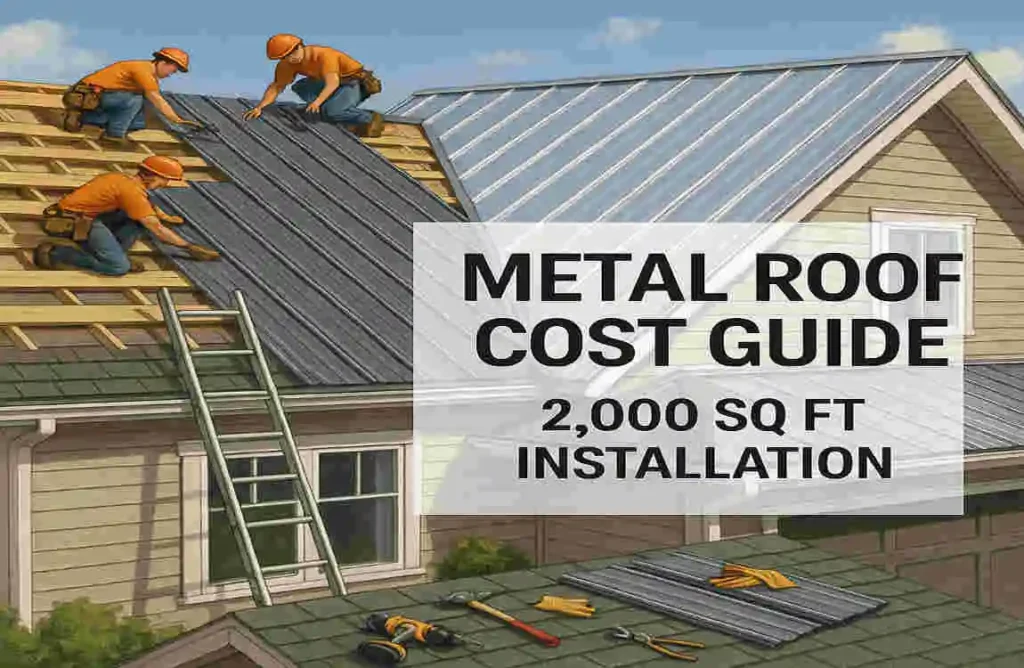Have you been wondering how much it costs to put a metal roof on a 2,000 sq ft house? You’re not alone. Metal roofing has surged in popularity over the past decade, and for good reason. More homeowners are discovering the incredible benefits these modern roofing systems bring to their properties.
As a real estate professional who’s passionate about home improvement, I’ve seen firsthand how a quality metal roof can transform a property. Not only does it boost curb appeal, but it also offers unmatched durability and energy efficiency that traditional roofing materials can’t match.
What is a Metal Roof?

Let’s start with the basics. A metal roof is a roofing system made from metal pieces or tiles that provide exceptional resistance, impermeability, and longevity. Unlike traditional asphalt shingles, metal roofing is available in a variety of materials and styles.
Types of Metal Roofing Materials
The most common metal roofing materials include steel, which remains the most popular choice due to its affordability and strength. Aluminum follows closely behind, offering excellent corrosion resistance and lightweight properties. For those seeking Premium options, copper provides stunning aesthetics that develop a beautiful patina over time, while zinc offers exceptional longevity with minimal maintenance requirements.
Each material offers its own set of advantages. Steel roofing, for instance, typically comes with protective coatings that prevent rust and enhance durability. Aluminum naturally resists corrosion, making it ideal for coastal homes where salt air can corrode other materials.
Key Advantages of Metal Roofing
The benefits of choosing metal roofing extend far beyond mere aesthetics. These roofs typically last 40 to 70 years, compared to traditional asphalt shingles that need replacement every 15 to 30 years. They’re incredibly energy-efficient too, reflecting solar radiant heat and potentially reducing cooling costs by 10-25%.
Metal roofs also excel in extreme weather conditions. They can withstand wind gusts up to 140 miles per hour, won’t corrode or crack, and are impact-resistant. Plus, they’re environmentally friendly, often containing 25-95% recycled content and being 100% recyclable at the end of their life.
Popular Metal Roof Styles
For residential applications, you’ll find several attractive styles to choose from. Standing seam metal roofs feature raised vertical seams that create clean, modern lines. Metal shingles mimic the appearance of traditional roofing materials while providing metal’s superior performance. Corrugated panels offer a more rustic or industrial look, while stone-coated steel tiles combine the strength of metal with the aesthetic appeal of traditional tiles.
Factors Affecting Metal Roof Costs
Understanding what influences the final price tag helps you prepare a realistic budget. Let’s explore the key factors that determine how much you’ll invest in your new metal roof.
Material Type and Grade Impact
The type of metal you choose significantly affects your overall costs. Basic steel panels represent the most budget-friendly option, typically ranging from $3 to $7 per square foot for materials alone. Aluminum roofing costs slightly more — usually between $4 and $9 per square foot — but offers superior corrosion resistance.
Premium materials like copper can cost anywhere from $9 to $14 per square foot, while zinc ranges from $6 to $12 per square foot. The grade or thickness of the metal also matters. Thicker gauges provide better durability but come with higher price tags.
Roof Complexity and Pitch Considerations
Your roof’s design plays a crucial role in determining installation costs. A simple gable roof with two slopes costs significantly less to Install than a complex roof with multiple valleys, dormers, and varying pitch angles. Steeper roofs require additional safety equipment and take longer to Install, increasing labor costs.
Roofs with numerous penetrations for chimneys, skylights, or vents require additional flashing and careful installation around these features. Each additional complexity adds to both material and labor expenses.
Geographic Location Variations
Where you live dramatically impacts your metal roofing costs. Labor rates vary significantly across different regions, with metropolitan areas typically charging more than rural locations. Material costs also fluctuate based on local availability and transportation distances from suppliers.
Climate considerations affect pricing, too. Areas prone to severe weather might require stronger fastening systems or additional underlayment, increasing overall costs. Local building codes and permit requirements also vary by location, potentially adding to your project expenses.
Tear-off vs. Overlay Decisions
You’ll face an important decision: removing your existing roof or installing metal panels over it. Complete tear-off adds $1 to $5 per square foot to your project but ensures a clean installation surface and allows inspection of the roof deck for damage.
Installing over existing shingles saves on disposal costs and labor, but it isn’t always possible. Building codes in many areas limit you to two roof layers, and some metal roofing systems require the complete removal of old materials to remain under warranty.
Additional Features and Upgrades
Several add-ons can enhance your metal roof’s performance but increase costs. High-quality underlayment provides extra protection against moisture and costs $0.50 to $1.50 per square foot. Insulation upgrades improve energy efficiency but add $1 to $3 per square foot to your budget.
Special fasteners designed for your specific metal roofing system ensure proper installation and longevity. These specialized components cost more than standard fasteners but are essential for maintaining your warranty and ensuring long-term performance.
Cost Breakdown for Installing a Metal Roof on a 2,000 Sq Ft House
Now let’s dive into the specific numbers you’re looking for. Understanding each cost component helps you budget accurately for your project.
Material Costs Per Square Foot
For a 2,000 square foot house, you’ll need approximately 2,100 to 2,200 square feet of roofing material to account for waste and overlap. Here’s what you can expect to pay for materials:
Steel panels typically cost $3 to $7 per square foot, meaning materials alone for your 2,000 sq ft house would range from $6,300 to $15,400. Aluminum options at $4 to $9 per square foot would cost between $8,400 and $19,800 for materials. Premium copper roofing at $9 to $14 per square foot could set you back $18,900 to $30,800 just for materials.
These prices reflect material costs only and don’t include installation, additional supplies, or other project expenses.
Labor Cost Estimates
Professional installation represents a significant portion of your total investment. Labor costs typically range from $3 to $7 per square foot for metal roof installation. For your 2,000 sq ft house, expect to pay between $6,000 and $14,000 for professional installation.
Experienced contractors charge more but often complete work faster and with fewer complications. The complexity of your roof design, local labor rates, and the time of year all influence these costs. Peak roofing season (late spring through early fall) often sees higher labor rates due to increased demand.
Additional Materials and Supplies
Beyond the main roofing panels, you’ll need various supplies for a complete installation. Underlayment costs approximately $1,000 to $3,000 for a 2,000 sq ft roof. Flashing for valleys, edges, and penetrations adds another $500 to $1,500 to your budget.
Ridge vents and other ventilation components cost $300 to $600. Fasteners, sealants, and trim pieces typically add another $500 to $1,000. Don’t forget about drip edge and gutter aprons, which protect your roof’s edges and cost around $200 to $500.
Disposal and Removal Fees
If you’re removing an existing roof, disposal fees can’t be ignored. Tear-off and disposal typically costs $1 to $5 per square foot, meaning $2,000 to $10,000 for your 2,000 sq ft house. This wide range depends on the number of existing layers, local disposal fees, and accessibility of your roof.
Some contractors include disposal in their quotes, while others list it separately. Always clarify what’s included to avoid surprise charges. Recycling old shingles can reduce disposal costs.
Permitting and Inspection Fees
Most localities require permits for roof replacement. Permit costs vary widely but typically range from $150 to $500 for residential roofing projects. Some areas base permit fees on project value, charging 1-2% of the total cost.
Inspection fees might be included in your permit cost or charged separately. Budget $100-$300 for required inspections. Some areas require multiple inspections during different project phases, potentially increasing these costs.
Example Metal Roof Cost Estimation for a 2,000 Sq Ft House
Let’s look at three realistic scenarios to help you understand the total investment for different metal roofing options.
Budget-Friendly Steel Panel Installation
For homeowners seeking affordable metal roofing, basic steel panels offer excellent value. Here’s a breakdown for a simple 2,000 sq ft roof:
- Materials: Steel panels at $4 per sq ft = $8,400
- Labor: Basic installation at $4 per sq ft = $8,400
- Additional supplies: Underlayment, fasteners, trim = $2,000
- Tear-off and disposal: Existing single layer = $3,000
- Permits and fees: = $300
Total estimated cost: $22,100
This option provides durable, long-lasting protection without breaking the bank. You’ll get a quality metal roof that outperforms traditional shingles while staying within a reasonable budget.
Mid-Range Painted Aluminum Option
Stepping up to painted aluminum panels increases both aesthetics and performance. This popular choice balances cost with Premium features:
- Materials: Painted aluminum at $6.50 per sq ft = $13,650
- Labor: Professional installation at $5 per sq ft = $10,500
- Additional supplies: Premium underlayment and accessories = $3,000
- Tear-off and disposal: = $3,500
- Permits and fees: = $400
Total estimated cost: $31,050
This mid-range option offers excellent corrosion resistance, attractive color options, and strong warranty coverage. It’s perfect for homeowners who want superior performance without the Premium price tag.
Premium Copper Roofing System
For those seeking the ultimate in luxury and longevity, copper roofing delivers unmatched beauty and performance:
- Materials: Copper panels at $12 per sq ft = $25,200
- Labor: Specialized installation at $7 per sq ft = $14,700
- Additional supplies: High-end components = $4,500
- Tear-off and disposal: = $4,000
- Permits and fees: = $500
Total estimated cost: $48,900
While the initial investment is substantial, copper roofing can last over 100 years with minimal maintenance. Its distinctive appearance and exceptional durability make it a worthwhile investment for luxury homes.
How to Budget for Your Metal Roof Installation
Smart budgeting keeps your project financially on track. Here’s how to prepare effectively for your metal roofing investment.
Creating an Accurate Estimate
Start by measuring your roof accurately. While online calculators provide rough estimates, nothing beats a professional measurement. Add 10-15% to your material calculations for waste and unexpected issues.
Factor in seasonal timing when budgeting. Off-season installations (late fall or winter in most areas) often come with contractor discounts. However, weather delays might extend project timelines during these periods.
Don’t forget to budget for the unexpected. Set aside an additional 10-20% of your estimated cost for surprises like deck repairs, additional ventilation needs, or code compliance updates discovered during installation.
Getting Multiple Contractor Quotes
Always obtain at least three detailed quotes from reputable contractors. Each quote should itemize materials, labor, disposal, and any additional costs. This transparency helps you compare apples to apples and identify potential red flags.
Look beyond the bottom line. The lowest bid isn’t always the best value. Consider factors like warranty coverage, contractor experience, and included services. A slightly higher bid from an experienced contractor with excellent reviews often provides better long-term value.
Ask each contractor about their installation timeline and crew size. Faster isn’t always better, but extended timelines increase the risk of weather-related delays and potential damage to exposed areas.
Essential Questions for Contractors
Before signing any contract, ask these crucial questions:
“What specific materials and brands will you use?” Ensure the quoted materials match your expectations and research their warranty terms.
“Are there potential hidden costs?” Discuss scenarios that might increase costs, such as discovering rotted decking or needing additional ventilation.
“What’s your payment schedule?” Reputable contractors typically request a deposit (usually 10-30%) with the balance due upon completion. Be wary of contractors demanding large upfront payments.
“How do you handle weather delays?” Understand their policies for protecting your home during installation and any timeline adjustments for weather interruptions.
Cost Comparison: Metal Roof vs. Other Roofing Materials on a 2,000 Sq Ft House
Understanding how metal roofing compares to other options helps justify your investment. Let’s examine the key differences:
Roofing Type Average Cost per Sq Ft Total Cost (2,000 sq ft)Lifespan (Years)Maintenance Needs Energy Efficiency
Metal Roofing $7 – $14 $14,000 – $28,000 40-70 Low High
Asphalt Shingles $3 – $6 $6,000 – $12,000 15-30 Moderate Low
Tile Roofing $10 – $20 $20,000 – $40,000 50+ Low Moderate
Wood Shakes $6 – $12 $12,000 – $24,000 20-40 High Moderate
Slate $15 – $30 $30,000 – $60,000 75-100 Low Moderate
While asphalt shingles cost less initially, their shorter lifespan means you’ll likely replace them twice during one metal roof’s lifetime. This makes metal roofing more economical in the long term, despite its higher upfront costs.
Tile roofing offers comparable longevity but weighs significantly more, potentially requiring structural reinforcement that adds to costs. Metal provides similar durability at a fraction of the weight.
Longevity and Return on Investment (ROI) of Metal Roofs

Your metal roof investment pays dividends over time through various financial benefits.
Extended Lifespan Benefits
A properly installed metal roof lasts 40-70 years, compared to 15-30 years for asphalt shingles. This longevity means you’ll likely never need to replace your roof again, saving tens of thousands in future replacement costs.
The durability of metal roofing also means fewer repairs over its lifetime. While asphalt shingles may need frequent patching after storms, metal roofs typically withstand severe weather without damage.
Energy Savings and Insurance Benefits
Metal roofs reflect solar heat, reducing cooling costs by 10-25% during summer months. For a typical home spending $2,000 annually on energy, this translates into $200-$500 in annual savings. Over 40 years, you could save $8,000-20,000 on energy costs alone.
Many insurance companies offer Premium discounts for metal roofs due to their fire resistance and durability. These discounts typically range from 5% to 35% of your homeowner’s insurance Premium, providing ongoing savings throughout your roof’s life.
Property Value Enhancement
Real estate studies consistently show that metal roofs increase home values. Buyers appreciate the longevity, low maintenance requirements, and energy efficiency. Homes with metal roofs typically sell faster and for 1-6% more than comparable properties with traditional roofing.
This increased value becomes particularly important if you’re planning to sell within 10-15 years. The modern appearance and known durability of metal roofing appeal to quality-conscious buyers willing to pay Premium prices.
Maintenance and Repair Costs for Metal Roofs
One of metal roofing’s most significant advantages is its minimal maintenance requirements. Understanding these needs helps you budget for long-term ownership.
Routine Maintenance Requirements
Annual inspections keep your metal roof performing optimally. These typically cost $150-300 and involve checking fasteners, sealants, and flashing. Many homeowners handle basic inspections themselves, saving these costs.
Cleaning your metal roof once or twice a year prevents debris buildup and maintains its appearance. Professional cleaning costs $200-500, though many homeowners use a garden hose and soft brush to handle this task themselves.
Keep gutters clear to prevent water backup that could damage roof edges. Trim overhanging branches that might scratch the roof surface during storms. These simple maintenance tasks extend your roof’s life and maintain its warranty.
Typical Repair Scenarios
While metal roofs rarely need repairs, understanding potential issues helps you budget accordingly. Fastener replacement might be required after 20-30 years, costing $500-1,500, depending on roof size.
Sealant touch-ups around penetrations and flashing cost $200-500 every 10-15 years. Storm damage, while rare, might require panel replacement at $500-1,500 per damaged section.
Compare these minimal repair costs to those of asphalt shingles, which need $500-2,000 in repairs every 5-10 years. Over the lifetime of your metal roof, you’ll save thousands in repair costs.
Financing Options for Metal Roof Installation
Don’t let upfront costs deter you from investing in a quality metal roof. Several financing options make this improvement accessible.
Traditional Financing Methods
Home equity loans offer fixed rates and predictable payments, making budgeting easier. Current rates typically range from 6% to 8%, and interest may be tax-deductible. Borrow only what you need and compare rates from multiple lenders.
Personal loans provide quick funding without using home equity. While rates are higher (8-15%), approval is often faster and requires less paperwork. These work well for smaller projects or when you want to preserve home equity.
Many contractors offer in-house financing through partnerships with lenders. These programs often feature promotional rates or deferred interest periods. Please read the terms carefully and compare them to traditional financing options.
Rebates and Incentive Programs
Check for local utility rebates for energy-efficient roofing. Some utilities offer $500-$2,000 for installing reflective metal roofing that reduces cooling loads.
State and federal tax credits might apply to certain metal roofing products. Energy Star-rated metal roofs may qualify for credits covering 10-30% of material costs. Consult a tax professional to understand current incentives.
Some areas offer property tax exemptions for energy-efficient improvements. While your home value increases, your property taxes might not, providing ongoing savings.
